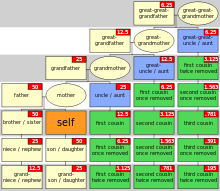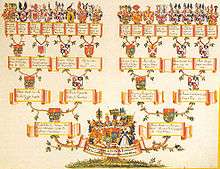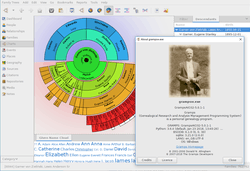Family tree
A family tree, or pedigree chart, is a chart representing family relationships in a conventional tree structure. The more detailed family trees used in medicine and social work are known as genograms.



Family history representations
Genealogical data can be represented in several formats, for example as a pedigree or ancestry chart. Family trees are often presented with the oldest generations at the top and the newer generations at the bottom. An ancestry chart, which is a tree showing the ancestors of an individual, will more closely resemble a tree in shape, being wider at the top than the bottom. In some ancestry charts, an individual appears on the left and his or her ancestors appear to the right. A descendancy chart, which depicts all the descendants of an individual will be narrowest at the top.
Family trees can have many themes. One might encompass all direct descendants of a single figure, or all known ancestors of a living person. Another might include all members of a particular surname (e.g. male-line descendants). Yet another approach is to construct a tree including all holders of a certain office, such as kings of Germany. This relies on dynastic marriage to hold together the links between dynasties.
Not every family tree is viewed from the side (pedigree or bracket chart). By looking down vertically at the top of a descendant tree, growing outward from one generation to the next, a family tree can be shown in a compact space. A time scale is used expanding radially about the center in decades. Children of the parent form branches around the center and their names are plotted in their birth year of the time scale. Spouse names join children names and families grow new branches to grandchildren, and so on. It is convenient to use great grandparents in the center to portray four or five generations, which appear in the natural growth pattern of a tree as seen from the top. In a descendant tree, living relatives are common on the outer branches and contemporary cousins appear adjacent to each other. Privacy should be considered when preparing a living family tree. [1]
The image of the tree probably originated with one in medieval art of the Tree of Jesse,[2] used to illustrate the Genealogy of Christ in terms of a prophecy of Isaiah (Isaiah 11:1). Possibly the first non-Biblical use, and the first to show full family relationships rather than a purely patrilineal scheme, was that involving family trees of the classical gods in Boccaccio's Genealogia deorum gentilium ("On the Genealogy of the Gods of the Gentiles"), whose first version dates to 1360.
Ahnentafel

An ahnentafel (German for "ancestor table") is a genealogical numbering system for listing a person's direct ancestors in a fixed sequence of ascent:
- Subject (or proband)
- Father
- Mother
- Paternal grandfather
- Paternal grandmother
- Maternal grandfather
- Maternal grandmother
and so on, back through the generations. Apart from No. 1, who can be male or female, all even-numbered persons are male, and all odd-numbered persons are female. In this scheme, the number of any person's father is double the person's number, and a person's mother is double the person's number plus one. This system can be displayed as a tree:

| 4. Paternal grandfather | |||||||||||
| 2. Father | |||||||||||
| 5. Paternal grandmother | |||||||||||
| 1 Subject (or proband) | |||||||||||
| 6. Maternal grandfather | |||||||||||
| 3. Mother | |||||||||||
| 7. Maternal grandmother | |||||||||||
Fan chart

A "fan chart" features a half circle chart with concentric rings: the person of interest is the inner circle, the second circle is divided in two (each side is one parent), the third circle is divided in four, and so forth. Fan charts depict paternal and maternal ancestors.
Graph theory
While family trees are depicted as trees, family relations do not in general form a tree in the sense of graph theory, since distant relatives can mate, so a person can have a common ancestor on their mother's and father's side. However, because a parent must be born before their child is born, a person cannot be their own ancestor, and thus there are no loops, so ancestry forms a directed acyclic graph.
The graphs of matrilineal descent ("mother" relationships between women) and patrilineal descent ("father" relationships between men) are trees however.
Assuming no common ancestor, an ancestry chart is a perfect binary tree, as each person has exactly one mother and one father, for two parents; these thus have a regular structure. A descendancy chart, on the other hand, does not in general have a regular structure, as a person can have any number of children, or none at all.
Notable examples
The longest family tree in the world is that of the Chinese philosopher and educator Confucius (551–479 BC), and he is the descendant of King Tang (1675–1646 BC). The tree spans more than 80 generations from him, and includes more than 2 million members. An international effort involving more than 450 branches around the world was started in 1998 to retrace and revise this family tree. A new edition of the Confucius genealogy was printed in September 2009 by the Confucius Genealogy Compilation Committee, to coincide with the 2560th anniversary of the birth of the Chinese thinker. This latest edition is expected to include some 1.3 million living members who are scattered around the world today.[3]
There are extensive genealogies for the ruling dynasties of China, but these do not form a single, unified family tree; and it is unclear at which point(s) the most ancient historical figures named become mythological.
In Japan, the ancestry of the Imperial Family is traced back to the mythological origins of Japan. The connection to persons from the established historical record begins in the mid-first millennium AD.
Another very old and extensive tree is that of the Lurie lineage—which includes Sigmund Freud and Martin Buber—and traces back to Jehiel Lurie, a 13th-century rabbi in Brest-Litovsk, and from there to Rashi and purportedly back to the legendary King David, as documented by Neil Rosenstein in his book The Lurie Legacy.[4] The 1999 edition of the Guinness Book of Records recorded the Lurie family in the "longest lineage" category as oldest-known living family in the world today.[5]
The Biblical genealogies of Jesus also claim descent from the House of David; covering a period of approximately 1000 years.
In the Torah and Old Testament, genealogies are provided for many biblical persons, including a record of the descendants of Adam.
According to the Torah, the Kohanim are descended from Aaron. Genetic testing performed at the Technion has shown that most modern Kohanim share common Y-chromosome origins, although there is no complete family tree of the Kohanim.
In the Islamic world, claimed descent from the prophet Mohammed greatly enhanced the status of political and religious leaders. New dynasties often used claims of such descent to help establish their legitimacy.
In Europe, the pedigree of Niall Noígíallach would be a contender for the longest, through Conn of the Hundred Battles (fl. 123 AD); in the legendary history of Ireland he is further descended from Breogán, and ultimately from Adam, through the sons of Noah. Many noble and aristocratic families of European and West-Asian origin can reliably trace their ancestry back as far as the mid to late first millennium AD; some claiming undocumented descent from Classical Antiquity or mythological ancestors.
Before the Dark Ages, in the Greco-Roman world, some reliable pedigrees dated back perhaps at least as far as the first half of the first millennium BC; with claimed or mythological origins reaching back further. Roman clan and family lineages played an important part in the structure of their society, and were the basis of their intricate system of personal names. However, there was a break in the continuity of records-keeping at the end of Classical Antiquity. Records of the lines of succession of the Popes and the Eastern Roman Emperors through this transitional period have survived, but these are not continuous genealogical histories of single families. See: descent from antiquity.
In Africa, the ruling dynasty of Ethiopia claimed descent from King Solomon via the Queen of Sheba. Through this claim, the family traced their descent back to the aforementioned House of David.
The genealogy of Ancient Egyptian ruling dynasties was recorded from the beginnings of the Pharaonic era circa 3000 BC, to the end of the Ptolomaic Kingdom; although this is not a record of one continuously-linked family lineage, and surviving records are incomplete.
Elsewhere in Africa, oral traditions of genealogical recording predominate. Members of the Keita dynasty of Mali, for example, have had their pedigrees sung by griots during annual ceremonies since the 14th century. Meanwhile, in Nigeria, many ruling clans - most notably those descended from Oduduwa - claim descent from the legendary King Kisra. Here too, pedigrees are recited by griots attached to the royal courts.
In some pre-contact Native American civilizations, genealogical records of ruling and priestly families were kept, some of which extended over at least several centuries.
In many human cultures, clan and tribal associations are based on claims of common ancestry; although detailed documentation of those origins is often very limited.
Other uses
The author Pete Frame is notable for having produced "family trees" of rock bands. In this instance, the entries represent membership of certain groups, and personnel changes within them, rather than family relationships. Several books have been produced with his family trees,[6] which in turn have led to a BBC television series about them, including interviews from the bands depicted in the trees.[7]
See also
References
- John Meng-Frecker, Family Tree Tops, https://familytreetops.com
- Simon Julian Gilmour (2000) Daz Sint Noch Ungelogeniu Wort: A Literary and Linguistic Commentary on the Gurnemanz Episode in Book III of Wolfram's Parzival. Universitätsverlag Winter, 2000. p.64
- Confucius family tree has two million members from China Daily, unknown date, updated February 16, 2008
- Neil Rosenstein, Ranan R. Lurie. The Lurie Legacy: The House of Davidic Royal Descent. ISBN 978-1-886223-17-2.
- Bill Gladstone (October 24, 2004). "The oldest family in the world". JTA.
- "Amazon - Even More Rock Family trees". Retrieved 20 September 2012.
- "BBC Four : Rock Family Trees". Retrieved 20 September 2012.
External links
![]()